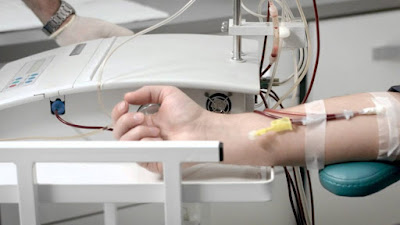Plasmapheresis Device; Used To Remove, Return, or Exchange Blood Plasma or Components
 |
| Plasmapheresis Device |
Plasmapheresis is a procedure in which blood is separated into
cells and plasma (liquid). It is the removal, treatment, and return or exchange
of blood plasma or components thereof from and to the blood circulation.
Plasmapheresis devices are used to collect plasma from human blood and convert
it into therapeutic products. These therapeutics are often used to treat a
range of diseases and conditions, including autoimmune diseases, hematologic
disorders, and renal disorders. Plasmapheresis
Devices are also used in plasma donation centers.
Plasmapheresis is a nonsurgical therapy that removes and replaces
a patient's blood plasma. It is used as a second-line therapy (after systemic
corticosteroids) in the management of central nervous system (CNS)
demyelinating diseases (such as neuromyelitis optica, idiopathic optic
neuritis, idiopathic transverse myelitis, acute disseminated encephalomyelitis,
among others) and multiple sclerosis (MS) relapses (or attacks). This in turn
has increased the use or demand for Plasmapheresis
Devices around the world.
Plasmapheresis is occasionally used in-patients who are intolerant
of high-dose corticosteroids or have medical contraindications to high-dose
corticosteroids. Therapeutic plasma exchange is a therapeutic procedure that
purifies the blood by removing pathogenic substances from the blood. This
procedure is most commonly used in the treatment of autoimmune and hematologic
diseases. The process removes large molecular-weight substances from the blood
that are not cleared from the blood by conventional hemodialysis or
hemofiltration.
Today, Plasmapheresis
Device is extensively used to treat Guillain-Barré syndrome, severe
myasthenia gravis, Lambert-Eaton syndrome, and chronic demyelinating
polyneuropathy. Its effectiveness, however, in other medical conditions such as
polymyositis, multiple sclerosis, and dermatomyositis, is still being studied.
The U.S. Food and Drug Administration (FDA) has granted 510(k) clearance for
the Aurora Xi Plasmapheresis System. The system collects plasma from donated
blood and returns the remaining blood components to the donor.



Comments
Post a Comment